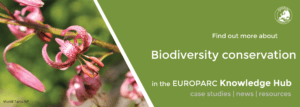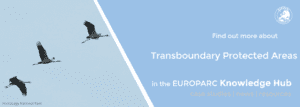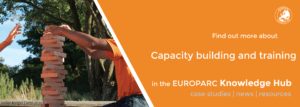Nature meets art. Or the other way around?
Päivi Tiura People with bathing suits on the beach from not dated
During the Conference 2019 in Latvia, EUROPARC held a number of workshops to discuss diverse topics relevant for Protected Areas management. In case you have not attended, or want to read about their outcomes, a series of online articles summarises the content of some of these workshops.
Nature has always inspired artists – painters, song writers, composers, dancers… Nature is the source of art. Art has been and will be inviting visitors – as individual artists or large groups like choirs – to Protected Areas. Art events at various scales can be arranged inside nature conservation sites to get new visitors to nature or used as a tool to interpret nature to various target audiences.
Art invites visitors to nature
Art may cause interesting controversies among nature and climate conservationists. The peat sculptures made in Latvia are beautiful as art pieces, if you happen to like them (see video). But why do we need to use centuries old carbon sink for art? Well, art has its freedom – we like some and don’t like other pieces of art.
Before we entered the topic of the real life of artists, we heard a presentation from Ms. Sanna-Kaisa Juvonen from Metsähallitus Parks and Wildlife Finland on the kinds of art events that have been organised in Finland. Lighting old castle ruins to depict the story of medieval Raasepori castle ruins was a spectacular way to bring light art into castle ruins (see video).
We also heard Finnish choirs sing the Finlandia hymn by Sibelius at nature day events celebrating the 100th anniversary of Finland (see video above).
During one day, over 1 500 singers performed nature related songs in 37 national parks.
Let’s make some art – it’s easy and fun
Within the workshop, participants were asked to recreate art in two different stages. First we selected over 50 Finnish paintings and asked people to make new interpretations of the paintings they liked in miniature scale using ”Slinkachu” approach. That means they should use small figures, usually used in mini railways.
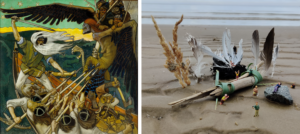
Akseli Gallen-Kallela Defending the Sampo from 1896
After a small break we gave them new instructions: ”now you are people in the paintings”. The same paintings were re-illustrated at full scale. It was easy, creative, and fun!
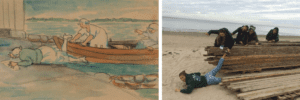
Elin Danielsson On the shore from 1904
We need more chances to talk with artists
As it happens, we are too often comfortably working in our own silos. We agreed in our group that we need to be more courageous and get in contact with artists. We need more platforms for joint discussions with people from different sectors. And also, we could simply invite more artists to our events focusing on nature. Moreover, we know that both creating art e.g. singing and being in nature is good for our mental and physical health. Double win!
Artists get to create art in nature, and we might get new visitors to our sites – interconnecting the nature and art sectors would be mutually beneficial.
It is a bit peculiar that at work we collaborate usually with our colleagues who are also working in the field of nature conservation. But in our private life, we can do very different kind of activities – we sing in choirs, make paintings, write poems, act in local theatre groups. You and your colleagues might actually be amateur artists, but we seldom use art in our work. Perhaps we should?
Let’s be more creative and next time you plan an event, think what role art could play in the event.
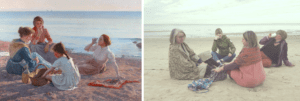
Elin Danielsson On the shore from 1904
Spreading knowledge about butterflies to protect habitats: a case study from Greece
Lycaena ottomanus recorded at Mount Lakmos. Photo: Bisa
Butterflies are good indicators of ecological condition. Based on their occurrence, it is possible to assess change and inform site managers for decision-making. All over Greece, butterfly diversity is very rich and the Tzoumerka National Park decided to make use of this asset to increase environmental awareness of the public and improve habitat protection.
Increasing environmental awareness
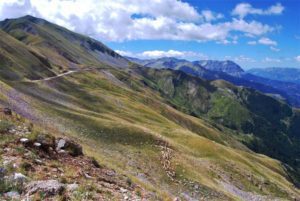
Alpine meadows are important habitats for butterfly species; Mount KATARAXIAS. Photo: BISA
The Tzoumerka Nartional Park is well aware of the fact that rich wildlife in combination with cultural features of the area are great preconditions to make it a thriving ecotourism destination. That is why they aim to obtain a complete list of butterfly species, identify the best sites to apply long term monitoring and protect their habitats.
The park hopes to attract butterfly-watchers and gain recognition as a butterfly destination. Moreover, they organise various activities to sensitise local communities about the importance of wildlife habitat conservation.
All over Greece, butterfly diversity is very rich and many protected and endemic species are recorded in various habitats.
Read the original case study on increasing knowledge about butterfly sites in Tzoumerka National Park, and another case study on monitoring snake populations.
In a nutshell, the project aims to:
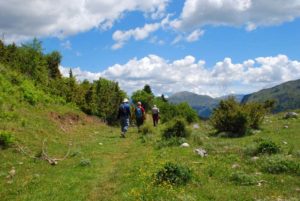
Members of the team visiting new sites near Kakarditsa in 2016. Photo: BISA
- Obtain a complete species-list for butterflies in Tzoumerka NP.
- Identify important areas for the protection of rare/protected species as well as areas with high butterfly diversity.
- Protect important butterfly habitats from anthropogenic threats.
- Contribute to the conservation objectives of the Habitats Directive (Council Directive 92/43/EEC on the Conservation of natural habitats and of wild fauna and flora).
- Attract butterfly-watchers in the NP.
- Raise awareness about butterfly habitats protection in local communities.
Butterfly monitoring
The Park cooperated with a group of experts with long experience on butterflies monitoring. More specifically, the scientific staff of the Park conducted surveys with the help of Lazaros Pamperis, a Greek butterfly expert and members of the Butterfly Conservation – European Interest Group. Surveys were repeated for several years, progressively including more new sites. Finally, a special survey was conducted to monitor Parnassius apollo and Parnassius mnemosyne when their habitats were identified.
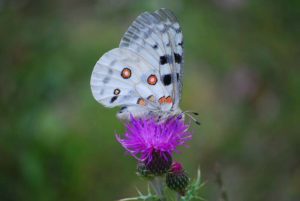
Parnassius apollo recorded at Mount Lakmos. Photo: Rika Bisa
The Park representatives held several meetings to inform local communities about the project. Shepherds were told to collect information about customs and practices related to the use of meadows, and experts in the tourist sector to collect information about visitors. The Park established a partnership with the Environmental Education Centre and organised educational activities to inform schoolchildren about biodiversity.
Once again we rediscovered the importance of sharing information with all the entities and involve experts and local stakeholders to implement conservation measures, protect species and habitats.
Results
Despite challenges such as lack of staff and equipment, which make the realisation of the goals more difficult, some results are already visible. Besides records of many of the winged beauties, important butterfly sites have been identified to apply monitoring projects. The Park established some new trails to enrich ecotourism in the area and began collaboration with local ecotourism agencies to improve its services. Moreover, the data collected helped to prevent habitat deterioration.
Do you have a story of protected area management around Europe that you would like to share as a case study? We will be happy to read it and promote it on our website! Submit your case study here.
30 years after the Fall of the Berlin Wall: Transboundary Parks Declaration
The Berlin Wall fell on the 9th November 1989. On the 30th anniversary, the European Transboundary Parks published a declaration highlighting the need to cooperate across frontiers.
Nature has no Borders
The EUROPARC’s network is characterised by making Protected Areas close to each other. They are however still separated by borders – virtual administrative, political and cultural walls – even in a now open Europe.
Since its birth, EUROPARC’s Transboundary Parks Programme, has embodied the spirit of the Fall of the Berlin Wall, on the basis of our day to day experience collaborating in the management of a shared biodiversity despite our political borders.
The experience of our history, our knowledge and values, led us to create a movement of active people, concretely co-operating and building projects to overcome barriers through the EUROPARC Transboundary Parks Programme: a true European project.
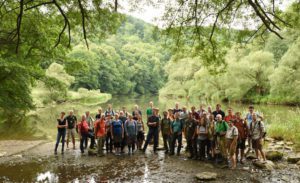
TransParcNet Meeting 2018. Author: D. Freudl
The inspiration derived from the Fall of the Wall is particularly evident given that most of our protected areas are located on the former Iron Curtain (now European Green Belt). Just looking at a map of Europe makes this very clear.
As equally evident is the energy and the will that the people involved in the Transboundary Programme put into the cooperation activities every day, driven by the pleasure of working together in once, long-time divided territories.
Commitment for peace, dialogue and nature protection
For these reasons and on this occasion we strongly declare our commitment for peace, dialogue and nature protection and our availability to support, in the frame of our institutional goals and skills, any initiative aimed at fostering cooperation between European states within and beyond the European Union.
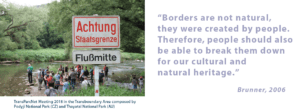
Europe is a complex continent with thousands of years of human interaction overlaying the natural world. The most obvious manifestations of that history are the many political borders that abound, and indeed change over time.
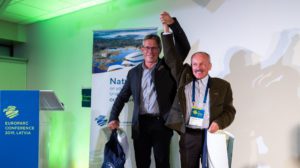
Award Ceremony at EUROPARC Conference 2019 – Welcome to the new Transboundary Park! Binntal – Veglia Devero Nature Park
Nature however, never recognizes these artefacts of human civilisation and our Protected Areas represent what is most special across our small, marvellous and populated continent and constitute a “shared European inheritance” of nature protection.
Yet in places borders create artificial barriers to the management of these valuable natural resources. The places where Protected Areas share a common political boundary bring these management issues into sharp focus and need special consideration.
The EUROPARC Transboundary “Following Natures Design” Programme seeks to support a process of mutual understanding, often between countries where history may have created mutual distrust, or administrative barriers and develop management tools to enable greater cooperative management.
Political borders create artificial barriers to the management of the valuable natural resources.
The Protected Areas awarded with the EUROPARC Transboundary Program Certificate compose the TransParcNet, an innovative platform for safeguarding cross-border biodiversity, ecosystem services and cultural landscapes, as well as inspiring and encouraging people for better understanding of the importance of transboundary cooperation.
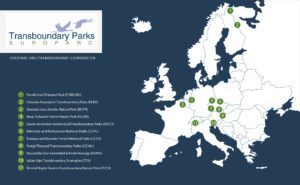
Download the Declaration and discover our Transboundary Areas.
Moreover, we would like to invite you and your networks to share your own memories of the fall of the Berlin Wall, by uploading a testimonial on the “My House of European History” platform. My House of European History aims to be a virtual library of testimonials and stories from people across Europe, and many nice uploads of people sharing their memories of the fall of the wall already feature.
Master programme in Management of Conservation Areas: Let’s talk about it!
Source: E.C.O. Institute of Ecology Facebook page
The Master programme in Management of Conservation Areas (MCA) opens international career paths in the management of Protected Areas, national parks, biosphere reserves or world heritage sites. The programme is offered by the E.C.O. Institute of Ecology together with the Carinthian University of Applied Sciences. Attend the info sessions to learn more!
Join the MCA Information Afternoons!
For anyone interested in the MCA Master programme, the E.C.O. Institute of Ecology is holding Information Afternoons in three different cities. The first session already took place in Klagenfurt (Austria) on Thursday 7 November, but if you have missed it, there are still two more to come in the following weeks.
Within the information afternoons, the MCA Team will present the programme, the teaching contents and the career prospects.
Don’t miss the opportunity to learn more and ask all your question!
For registrations and more information contact Caroline Fiedler at fiedler@e-c-o.at .
Information Afternoon in Bern, November 21
The second Information session will take place in Bern (Switzerland), on the 21st November 2019. The MCA Team will welcome you in the Berner Generationenhaus from 17:00 to 19:00.
Download the invitation with more details:
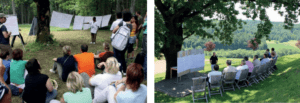
Source: MMCA flyer, e-c-o.at
Information Afternoon in Frankfurt am Main, November 27
The third info session will be held in Frankfurt am Main (Germany) on November 27th, at the Toyoko Inn Hotel, between 17:00 and 19:00.
Download the invitation with more details:
About the MCA Master programme
Unique in Europe, the comprehensive academic education allows for career growth in Protected Area management, in research and education, as well as in NGOs or international organizations. The key elements of the skills-oriented education are international cooperation and transcultural learning and working.
The study program comprises 120 ECTS, culminating in a Masters degree (M.Sc.) graduation. The course takes four semesters and can be completed while working full-time. In total, 64 attendance days are structured into eight modules of five to 13 days each. The courses take place at the Carinthian University of Applied Sciences as well as in selected Protected Areas in Central and Eastern Europe.
Next round: February 2020 – February 2022 (Application deadline: November 30, 2019).
